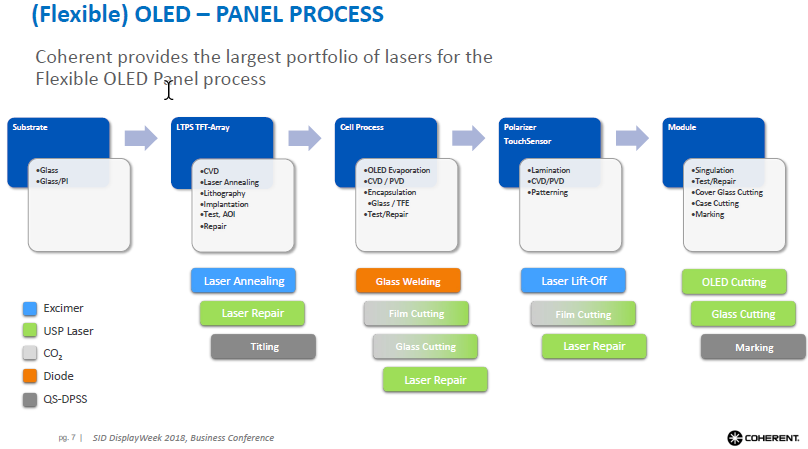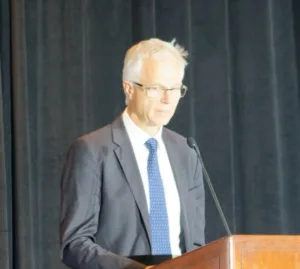Rainer is from Coherent which is a laser supplier based in Santa Clara. (We previously reported a talk from Paetzel from the 2011 Business Conference) It makes lasers that are used in the manufacturing processes for display manufacturing. A range of different lasers are needed for the different processes. Some are different according to the colour or frequency, while others supply energy continuously or in long or incredibly short pulse. These short pulses can provide huge power for a very short period.
The company has been working in the display industry for more than twenty years and LTPS was enabled by excimer laser (ELA) technology. OLEDs and flexible OLEDs also take advantage of the same kinds of substrate processes. There are also automotive, AR, VR and other applications. MicroLED is also an interesting development and likely to be a good application for lasers, Coherent believes.
One of the fundamental applications is laser annealing for the TFT backplane and is also used for display repair. In OLEDs, lasers can be used for glass sealing and the cutting of flexible displays can also use laser. Repair again uses lasers. Laser lift-off can be used for flexible OLEDs and then lasers can be used to cut the final display.

Excimer Laser Annealing (ELA) has been around for 20 years but became a critical technology for AMOLEDs. The use of ELA can mean a 4X improvement in silicon mobility and allows OLEDs to have the high quality of transistors that it needs. The length of the laser line has increased up to 1.5 metres, so a G6 substrate can be scanned in one line and the company could move to G7 if the industry moves to that size, Paetzel said.
For TV, the company could make a dual 1700 scan line which would allow even G10.5 to be made.
Laser lift off is used to take off the flexible film from the glass carrier that holds the film during OLED manufacture and it uses UV lasers.
Lasers can cut the glass and is really good when you need curves, holes and notch cuts. A two stage process can be used to cut out cover glass without touch and without ablation, so there are no particles. For some applications, the edge quality is good enough after laser cutting to eliminate the need for polishing.
Going to UV lasers, you can cut flexible films with a very small kerf (cut) width and without creating haze, making the process ideal for smartphones.
Lasers can be used for laser lift off and also for laser-induced forward transfer for dealing with microLEDs if they become a significant factor and the company is working in this area already.
Analyst Comment
Laser lift off problems are said to be a significant cause of yield loss in flexible OLED manufacture and in the Investors Conference, we heard from Ares which is making new materials to help reduce losses. (BR)

